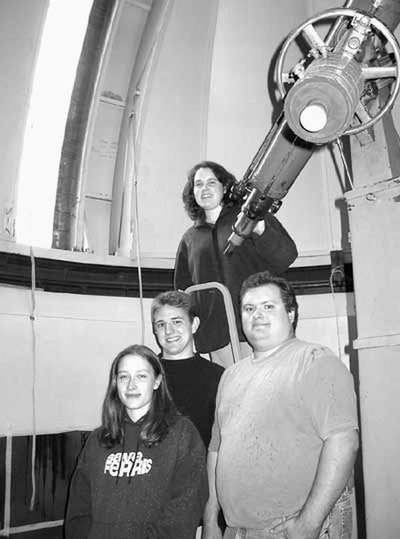October 11, 2001
Stargazing: Astronomy undergrads use old telescope for new interest
The observatory may be the second oldest building on campus, but it can still draw a crowd. That’s what it’s been doing for the past few months, thanks to the efforts of undergraduates in the Astronomy Department. The group offers public viewing nights at the observatory on the first and third Wednesday of every month. The next open night is Oct. 17.
The project started when astronomy lecturer Ana Larson and Professor Paula Szkody issued a plea to undergraduates asking for interest in working at the observatory. A number came forward and quickly narrowed down to a core group of eight.
“Before we went in there, the observatory hadn’t been used for nine months,” Larson said. “And before that, programs had been given by a private individual not connected with the astronomy department.”
The students’ first job, however, wasn’t one designed for an astronomer – they cleaned the place. “Dust, cobwebs, you name it,” said Hillary Cummings, one of the eight. The group also hung some astronomy-related pictures on the walls.
Once the place was in shape to greet the public, the students began working on programming. “We got together and collaborated on what the program should be each month and then one or two people would take responsibility for getting a presentation ready,” said Ali Hanks. Their first program was in May.
The programs change each month. They’re chosen to highlight some feature of the night sky that will be visible at that time. The group prepares a power point presentation of 15 to 30 minutes (longer on cloudy nights) and then visitors can look through the telescope to see an example of what they’ve been hearing about.
The telescope is more than 100 years old and has its original optics, so the view through it is equivalent to that of a backyard telescope. Nonetheless, the evenings have sometimes attracted as many as 60 or 70 people – so many, in fact, that crowd control is sometimes a problem. The classroom in the building holds 40 but the telescope room can only accommodate about 10 safely.
The students say they enjoy the presentations. “It helps us learn about the topic we’re presenting on and also about the telescope,” said Natalie Mintz another of the core group members.
“And the public is really enthusiastic,” Cummings added. “They ask interesting questions.”
The Astronomy Department has now turned what was an informal effort into a class so that the students can get credit for their work. There are about 20 students enrolled, learning to prepare and give power point presentations, and also how to use both the observatory’s telescope and the planetarium located in the new Physics/Astronomy Building.
The viewing on Oct. 17, which is on star clusters in the Milky Way Galaxy, is from 8 to 10 p.m. The presentation will be given at the beginning of the evening and probably repeated, depending on attendance.

